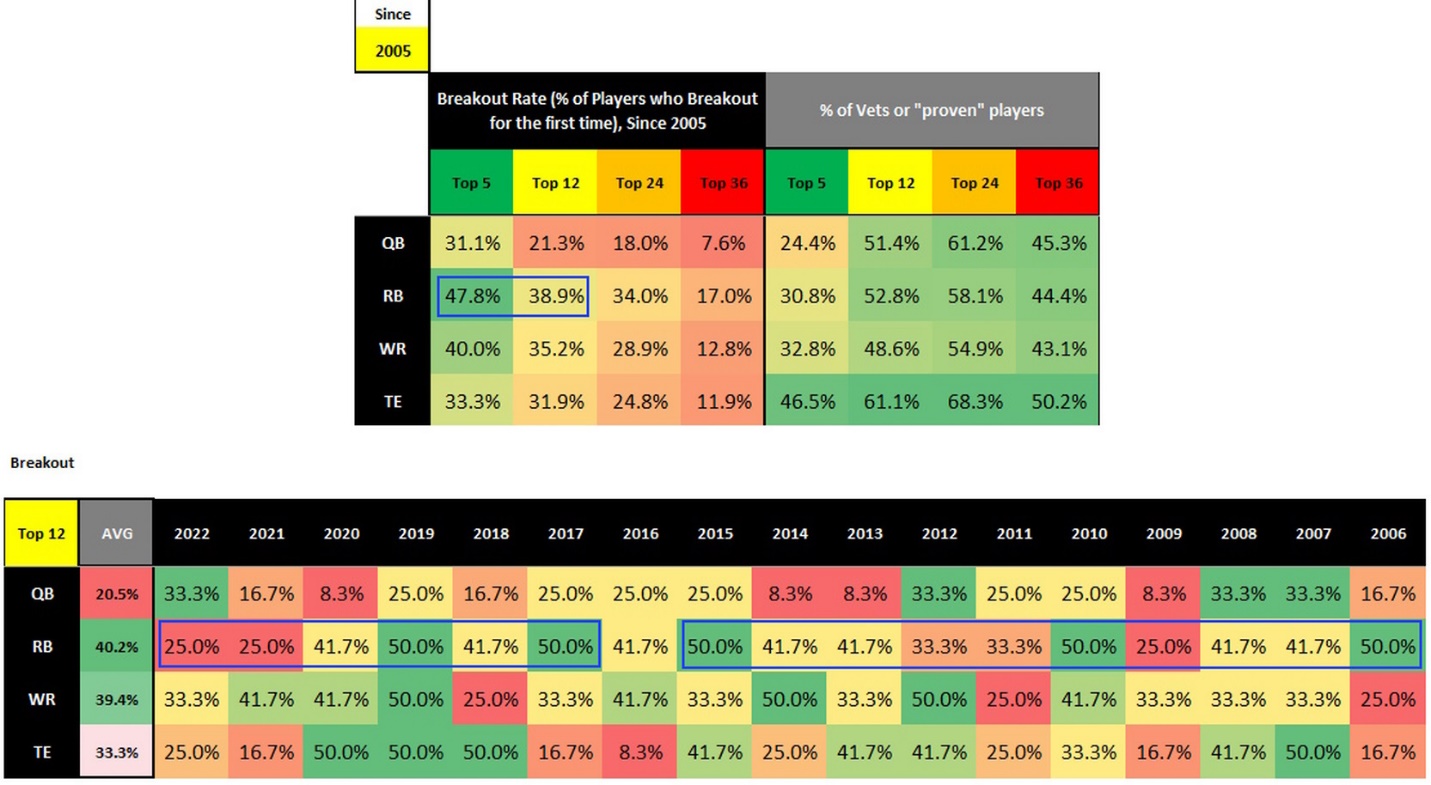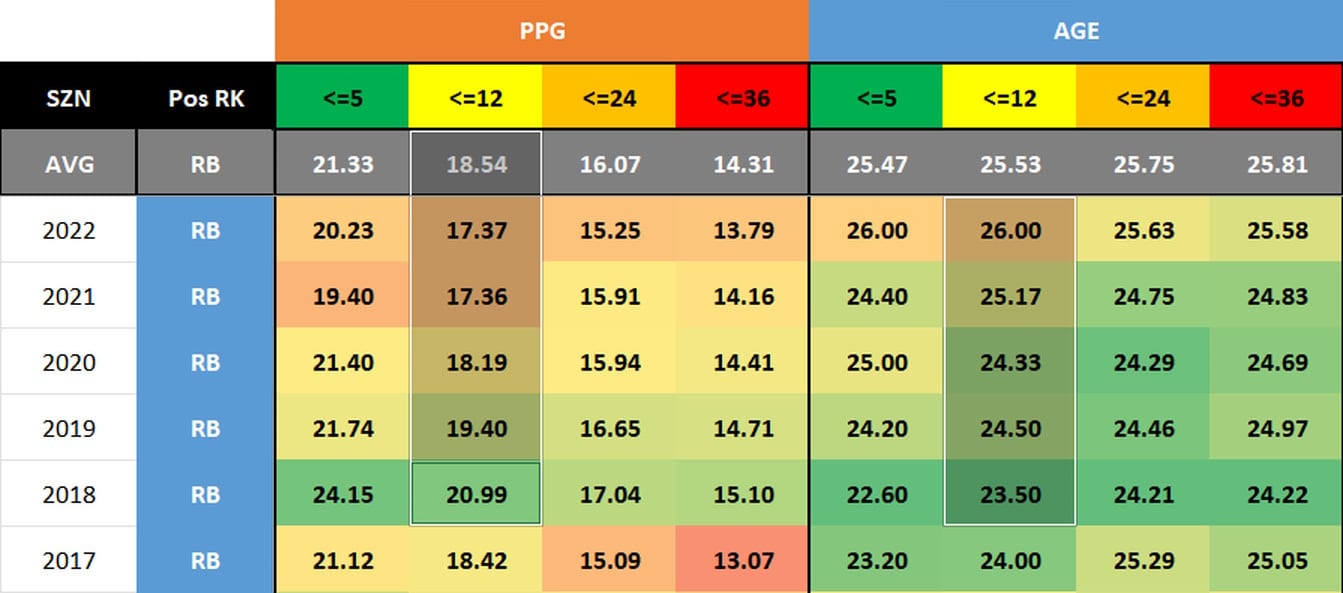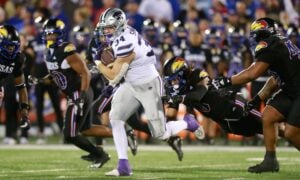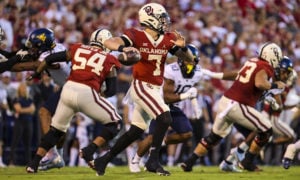Running Back Breakout Trends for 2023

Running backs are either going to implode forever or bounce back in 2023, and people know it. The average ADP for the top 12 running backs is 21.8 according to DLF’s latest update, that’s the lowest average for the position since 2016 (33.5). This isn’t for no reason. It’s a reasonable reaction to a return to previous lower levels of production dynasty has been haunted by before.
In the same time frame – 2018 to 2022 – the average points per game for the position have fallen every year from 20.9 in 2018 to 17.4 in 2022. The last two years are the lowest since 2015 (15 PPG) which itself came at the end of a nine-year decline for the top 12 running backs.
This was all changed by the 2017 class. But while 2023 isn’t going to be 2017, it should offer us more of the same. Are we at the start of another nine-year low for the position? Was 2017 just a blip on the radar that, for a moment, gave us hope for long-term value? Are we doomed to see only a few stars like Le’Veon Bell, and Jamaal Charles peak between the jagged rocks at the bottom of the cliff our dynasty teams are left to fall off?
In this article, I want to overview the expectations of the position and outline why I think we can find reasons to invest and be excited about the position in 2023.
Let’s talk about it.
Running back breakouts
So, there are a few things to know about running backs, their fantasy breakouts, and production trends.
Running backs breakout (finish inside certain position ranks for the first time) in year one more than any other position. They also represent the largest single breakout group in the top twelve and top five than any other position. In other words, more of the top five and top twelve players are first-time finishers in any given year and they are more likely to be rookies.
What’s more, despite the ebb and flow of fantasy point production, breakouts seem to revolve around certain levels of expectations in any given season regardless of the position’s overall production. For example, while there were down years in the nine years before 2015, as I mentioned in the intro, the breakout rate inside the top 12 for running backs was still above or beyond 41% (5/12) most years.

If we compare that to the past six years since 2017, we see that despite the reinvigoration of that class, breakouts didn’t represent more of the top 12 than previous years even in lower production periods, and the two-year drought we’ve seen for breakouts in 2021 and 2022 is also not unprecedented with the example of 2011 and 2012.
In short, we are “due” breakouts, even if the overall running back position doesn’t bloom back to its 20 PPG average in 2018.
Breakouts are coming, even if the 2017 class, version 2.0, is not.
Age and Expectation
Young players aren’t good, but most good players start young, and I think some elements of this idea have been undervalued by some.
It’s been so well understood and incorporated into dynasty theory that running backs age poorly, get injured more often, and break out more frequently, that ADP has long accounted for the difference between. But perhaps too far.

This isn’t complicated stuff either. Since 2017, the age of the top five and top 12 running backs has increased… because the 2017 class has represented a large portion of those finishes, and… they get older every year.
You still want 2017 running backs, even though they are older. However, we are likely coming toward the end of their dominance in the top 12, and we should expect more running back breakouts to be young players, recently drafted.
Projected breakouts
All this being mostly well understood, it’s not a surprise to see who the three top 12 running back breakouts are.
I use a selection of ADP and 2023 seasons-long rankings from dynasty and redraft sources to create a consensus projection. These three players would represent another 25% breakout rate, which I think is unlikely.

Having said that, not all breakouts are first-round NFL picks in their first or second season.
Looking at the average breakout running backs since 2005, their draft capital, and adjusting for the recent breakout trends over the last five years, I estimate the breakout potential of players who aren’t rookies, in an average formula. Of the top five results, only one of them is currently already on the expected top 12 list above, Breece Hall.

If all six were to break out, that would be 50% of the top 12, not unprecedented, but we’re unlikely to be that accurate. The future is a cold and wild target and not something we should have a lot of confidence in when it comes to predictions.
Having said that, Kenneth Walker, Dameon Pierce, and Rachaad White are all prime breakout candidates in a prime breakout year where we should have higher expectations of value-changing seasons. And it’s at a time when most teams, leagues, and ADP itself are lowering their value and expectation. In short, it’s undervaluing their potential.
I think 2023 is a year to shake off the well-intentioned, soundly reasoned, distaste for running backs in dynasty. Instead, let’s start taking some last-minute stands and take advantage of this lethargy.
Or that’s my 0.2 cents anyway.
- Peter Howard: Dynasty Fantasy Football Superflex Rankings Explained - March 6, 2024
- Dynasty Target and Regression Trends: Week 15 - December 23, 2023
- Dynasty Target and Regression Trends: Week 14 - December 16, 2023


































































